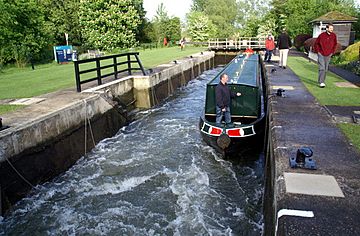Buscot Lock facts for kids

Buscot Lock, filling.
|
|
| Waterway | River Thames |
|---|---|
| County | Oxfordshire |
| Maintained by | Environment Agency |
| Operation | Manual |
| First built | 1790 |
| Length | 33.47 m (109 ft 10 in) |
| Width | 4.47 m (14 ft 8 in) |
| Fall | 1.69 m (5 ft 7 in) |
| Above sea level | 230' |
| Distance to Teddington Lock |
122 miles |
Buscot Lock is a special kind of lock found on the River Thames in England. It's located close to the village of Buscot in Oxfordshire.
This lock was built a long time ago, in 1790, using strong stone. It's actually the smallest lock on the entire River Thames! Like many older locks on the upper part of the Thames, Buscot Lock still uses its original heavy wooden beams. A lock keeper uses these beams to open and close the gates, helping boats move up and down the river.
A new weir was built here in 1979. A weir is like a small dam that controls the water level. This new weir is quite unusual in its design. It's now a lovely picnic spot managed by the National Trust. The area around the lock is full of amazing plants and animals. You might even spot otters, kites, or colorful kingfishers!
History of Buscot Lock
Before the current lock was built, there was a different system called a flash lock at Buscot weir. This older system also helped boats navigate the river.
When the modern lock was constructed, the weir was owned by a man named Edward Loveden Loveden. He was a big supporter of improving travel on the Thames. The lock was built by J. Nock, who also built another nearby lock called St John's Lock around the same time. People sometimes called Buscot Lock the "New Lock" back then.
The house where the lock keeper lives was built in 1791. It even has a special room for fish! The old weir was updated in 1909, but then it was replaced by the new weir and water channel in 1979.
Exploring Upstream from the Lock
The river above Buscot Lock takes some interesting turns. It winds and doubles back on itself quite sharply in this short section.
Just above the lock, you'll find Buscot Park. In 1859, a man named Robert Tertius Campbell bought the park. He built a factory there to make alcohol from sugar beet. He used water from the river to supply his estate with the help of water wheels. However, he closed the factory in 1879. Today, Buscot Park is owned by the National Trust.
Further upstream, you'll see the Bloomers Hole Footbridge crossing the river. Then, two other rivers join the Thames: the River Cole flows in from the south, and the River Leach joins from the north. Finally, the St John's Bridge marks the start of St John's Lock.
If you enjoy walking, the Thames Path follows the northern bank of the river. You can walk from Buscot Lock all the way to Bloomers Hole Footbridge, where the path then crosses to the other side of the river.

